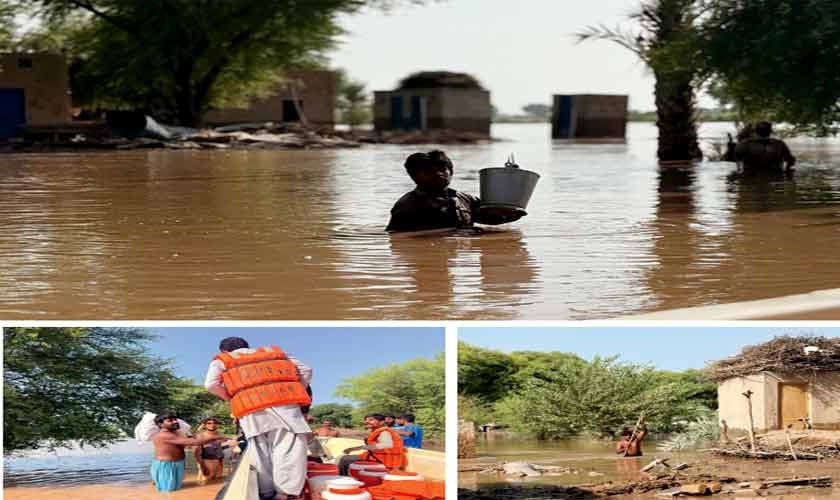
Alipur, located 95 kilometres from Muzaffargarh, now resembles a vast lake more than a town. On both sides of the broken road, there is water as far as the eye can see. Families are scattered across embankments — some sheltering under the open sky, others in fragile tents. Many clutch their national ID cards protected in plastic bags, the one possession they deemed worth saving, hoping it would serve as proof of identity and eligibility for aid.
Among them sits Shaheen, holding her six-month-old daughter in her arms. She waits patiently for a boat to Seetpur, 17 kilometres away, where floodwaters have recently swallowed the road. “There is no man to accompany me. Whatever I need to do, I will have to do on my own,” she says.
Not far from Shaheen, families from Ghouspur village sit together. Children quietly sit beside their mothers, their eyes brimming with longing as they wait for tents, food, and clean water. Before them lies an endless expanse of water.
A few kilometres further, a police official explains, “The road to Seetpur has been damaged for more than a week. You cannot reach it without a boat. Alipur has been declared a calamity-hit area.”
The extent of the destruction appears far greater than the figures provided by the local government. According to the latest data from the South Punjab Civil Secretariat:
– Over 1.6 million people have been impacted.
– Around 1.482 million individuals have been relocated to safer locations.
– More than 1.11 million acres of land have been submerged.
– Crops on approximately 1.188 million acres have been destroyed.
– Nearly 1.5 million cattle have been moved to safer areas.
– There have been 32 confirmed deaths.
Officials warn that as the waters recede, particularly in Jalalpur Pirwala and Alipur, the death toll could rise.
Farooq Ahmed, a Rescue 1122 spokesperson, reports that the hardest-hit districts include Multan, Muzaffargarh, and Rahim Yar Khan. So far, 3,274 people were rescued in Multan; 2,392 in Muzaffargarh; and 414 in Rahim Yar Khan.
The situation in Muzaffargarh district remains alarming. According to district administration data, 161 villages have been flooded, affecting 209,378 acres. In Alipur tehsil alone, 40 villages have been submerged. Nearly 395,000 people have been directly impacted by this disaster.
Superintending Engineer Hafiz Abdul Rehman from the Muzaffargarh Canal Circle explains the reasons behind the devastation in Alipur:
“Typically, floods feature one surge. This year, we experienced two peaks in quick succession, just a week apart. The intensity of the flooding was similar to 2014, but the water levels this time were significantly higher.”
He highlights the difference at Head Panjnad, stating that in 2014, the peak downstream flow reached 400,000 cusecs. This year, the first peak hit 600,000 cusecs, followed by a second peak of 700,000 cusecs. Additionally, while the Ravi and Sutlej Rivers contributed little water in 2014, this time all three rivers — Ravi, Sutlej, and Chenab — combined to create an unprecedented flood. The Indus River flows surged to 250,000 cusecs as well.
While the overall magnitude of the flood may appear similar, the water levels were significantly higher.
Rehman adds that protective infrastructure could have mitigated the damage. An embankment in Azmatpur was proposed after the 2014 floods, and again in 2016, but local resistance and High Court orders hindered its construction.
Much of the relief efforts are currently carried out by citizens, supported by some NGOs and Rescue 1122. Rehan Khan, a resident of Alipur, accompanied by a team of volunteers, has been delivering food to survivors for over a week.
“Many people stayed behind to protect their homes while sending their families away. I met people who hadn’t eaten for five or six days,” he says.
Imran Abbas, a Rescue 1122 officer, shares his experience aboard a rescue boat:
“I have been here for a week after having worked in other districts since August 26. Alipur is the toughest place I have encountered,” he says. “The main issue after evacuations is the lack of safe drinking water. I have personally rescued 300 people.”
After several hours covering submerged houses and delivering food, they reached Latti Maari, where many people awaited supplies.
Muhammad Tanveer, a 17-year-old resident, had stayed behind while his family was evacuated.
“The women and children left, but we chose to stay and protect what was left of our homes. I lost three cattle and three rooms of my house collapsed,” he says.
Mustafa, another resident, recounts being surrounded by water for over a week, wearing just a single chador.
“God will make things better,” he says. His six-room house now has only three rooms standing.
He insists on staying to protect what little remains, fearing theft. “Men in private boats come and steal from the abandoned houses.”
Sub-inspector Waseem Khan, Muzaffargarh police public relations officer, reports no theft complaints have been filed. “Our officers are conducting daily boat patrols,” he adds. “We didn’t anticipate this situation in Alipur.”
Chief Minister Maryam Nawaz Sharif visited the affected area, and Senior Minister Marriyum Aurangzeb remained on site throughout the rescue operations in flood-affected Alipur.
The Pakistan Army, Navy, Rescue 1122, police, and local administration are all involved in what officials describe as a major rescue operation.
Officials warn that the true extent of damage and loss of life will only become clear in the coming days as floodwaters recede. Authorities do not see further flooding as a threat.
Rescue 1122 teams have started transporting families by boat back to their homes so they can inspect the damage. However, road access to Seetpur and nearby villages remains cut off.
Meanwhile, health risks are rising among displaced families living in tents and open areas, underscoring the urgent need for continued relief efforts.
https://www.thenews.com.pk/tns/detail/1345064-far-from-over





